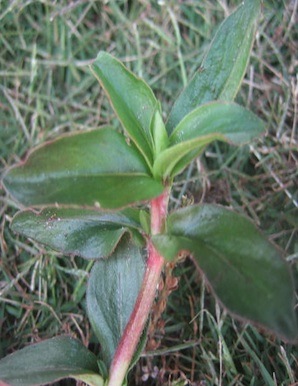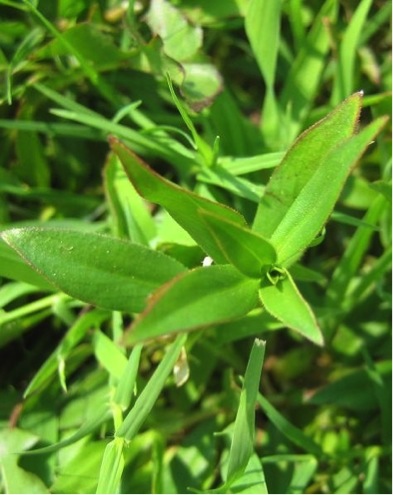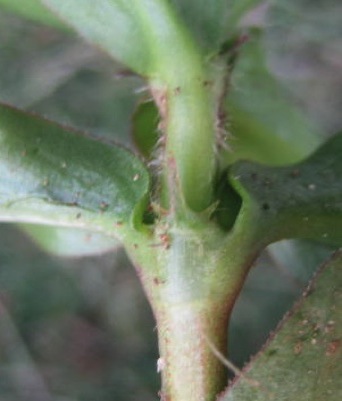- Cultural Control
- Preemergence Herbicides
- Postemergence Herbicides
- Table 1. Mowing requirements for lawns in Georgia
- Table 2. Efficacy of postemergence herbicides for Virginia buttonweed control in turfgrass
- Table 3. Turfgrass tolerance to herbicides for Virginia buttonweed control
Virginia buttonweed (Diodia virginiana L.) is a troublesome broadleaf weed in turfgrass throughout the southeastern United States. Virginia buttonweed is a deep-rooted perennial with prostrate or spreading branches. It usually proliferates in moist to wet areas and can tolerate mowing heights as low as one-half inch. The species is a member of the Rubiaceae family and is found from New Jersey, west to Missouri and south into the Gulf Coast states.
 Picture 1. Virginia buttonweed in a bermudagrass lawn. Photo by P. McCullough.
Picture 1. Virginia buttonweed in a bermudagrass lawn. Photo by P. McCullough. Picture 2. Virginia buttonweed growing in a tall fescue lawn. Note reddish coloration on leaf margins. Photo by P. McCullough.
Picture 2. Virginia buttonweed growing in a tall fescue lawn. Note reddish coloration on leaf margins. Photo by P. McCullough. Picture 3. Viriginia buttonweed stems. Note hairs and fleshy appendage where leaves join stems. Photo by P. McCullough.
Picture 3. Viriginia buttonweed stems. Note hairs and fleshy appendage where leaves join stems. Photo by P. McCullough.Virginia buttonweed leaves are slightly thickened, opposite without petioles and slightly rough along the margins (Picture 1). Leaves are green on the upper surface, light green on the lower surface and often have a mottled yellow mosaic appearance caused by a virus that commonly infects foliage (Picture 2). Branched stems are occasionally hairy (Picture 3) and reproduction occurs via seeds, roots or stem fragments. Flowers are white with four star-shaped petals, which sometimes have pink streaks in the center and two sepals. Fruit are green, elliptically shaped, hairy and ridged.
Cultural Control
Removing Virginia buttonweed by hand is often ineffective because creeping roots or fragments left behind may establish a viable plant. Several cultural practices can be utilized to control or reduce pressure of Virginia buttonweed in lawns. Deep and infrequent irrigation encourages turfgrass root development, which may improve the ability of desired grasses to compete with perennial weeds in mixed stands. Withholding water until desirable grasses exhibit initial drought stress symptoms can help reduce soil moisture for potential weed infestations. Overwatering or excessive rainfall during growing periods may predispose the site to the invasion of Virginia buttonweed.
Practices that promote soil compaction should be avoided to promote turfgrass growth and competition with Virginia buttonweed populations. If possible, turf managers should redirect traffic away from stressed areas to help promote turfgrass recovery over thinned areas. Core aerifications should be conducted during active turf growth and favorable periods for quick recovery. Voids left in turf with exposed soil following aerifications may permit weed invasion during periods of peak germination. For tall fescue, aerificiations should be timed in early fall once the grass has recovered from summer stresses. Warm-season grasses should only be aerified during active growth to promote recovery. Early spring aerification may predispose lawns to summer annual weed establishment since the grasses are not able to fill in voids in a timely manner.
Mowing height, frequency and equipment requirements vary among turfgrass species and practitioners should maintain turf under appropriate regimes for successful long-term culture (Table 1). Raising the mowing height during peak establishment of Virginia buttonweed may encourage turf competition and reduce potential infestations. Turfgrasses should also be mowed frequently during periods of vigorous growth to prevent scalping, which thins out turf and may enable weeds to establish. While returning clippings is recommended to recycle nutrients to the soil, removal of clippings may be useful to reduce further infestations of lawns with Virginia buttonweed seed and runners.
Preemergence Herbicides
Most preemergence herbicides provide poor control (< 70%) of Virginia buttonweed in turf. Virginia buttonweed plants emerging from vegetative structures will not be controlled by currently available preemergence chemistries. Some preemergence herbicides, such as indaziflam (Specticle), isoxaben (Gallery) and oxadiazon (Ronstar), have the potential to control Virginia buttonweed emerging from seed, but results are often inconsistent.
Postemergence Herbicides
Several postemergence herbicides effectively control Virginia buttonweed in turfgrass. Sulfonylurea herbicides are widely used in turf for controlling cool-season grasses, broadleaf weeds, and sedges. Sulfonylureas inhibit branch-chain amino acid synthesis and are popular herbicides for postemergence weed control in warm-season grasses. Chlorsufluron (Corsair), metsulfuron (Manor, others) and trifloxysulfuron (Monument) are sulfonylureas for use in Southern lawns with activity on Virginia buttonweed (Table 2). Efficacy of these herbicides is generally greater under warm temperatures in summer, compared to spring, and repeat applications are often necessary for controlling Virginia buttonweed.
Trifloxysulfuron is the most effective sulfonylurea for Virginia buttonweed and may be safely applied to bermudagrass and zoysiagrass. Trifloxysulfuron treatments may provide good control (80 to 89%) of Virginia buttonweed and repeat applications have potential to provide complete control. Chlorsulfuron (Corsair) is generally less efficacious on Virginia buttonweed than trifloxysulfuron, but repeat applications may suppress populations. Most warm-season grasses have intermediate tolerance to chlorsulfuron (Table 3) and may be discolored or slightly injured following applications.
Metsulfuron is widely used in southern lawns and most major warm-season grasses have good tolerance to treatments. Metsulfuron (60WG) applications from 0.25 to 0.5 oz. of product per acre can effectively control annual broadleaf weeds but repeat applications only provide fair activity (70 to 79% control) on Virginia buttonweed. Blindside contains metsulfuron + sulfentrazone and two applications have been shown to provide better control of Virginia buttonweed than metsulfuron alone. Tall fescue and other cool-season grasses are susceptible to chlorsulfuron, metsulfuron, and trifloxysulfuron at application regimens and rates required for effective Virginia buttonweed control. The addition of a non-ionic surfactant at 0.25% vol/vol is recommended to facilitate spray retention and absorption of these herbicides.
Celsius is a combination product that contains a sulfonylurea, iodosulfuron, with thiencarbazone and dicamba. Single applications of Celsius have been shown to provide good to excellent control (80 to 100%) of Virginia buttonweed (Table 2). Celsius may be applied to control grassy and broadleaf weeds in bermudagrass, centipedegrass, St. Augustinegrass and zoysiagrass or lawns with mixtures of these species. Celsius controls other troublesome weeds including bull paspalum, doveweed and spotted spurge. Tribute Total is another combination product that contains three ALS-inhibitors including thiencarbazone, foramsulfuron, and halosulfuron. It can only be applied to bermudagrass and zoysiagrassturf. Sequential applications at 3.2 oz/acre four to six weeks after initial treatments may be needed to control Virginia buttonweed regrowth.
The addition of synthetic auxin herbicides, such as dicamba, with sulfonylurea herbicides may improve activity for Virginia buttonweed control. Dicamba is a benzoic acid herbicide commonly found in prepackaged mixtures with 2,4-D and other broadleaf herbicides. Individual components of these mixture products have fair activity when applied alone and combination products are generally more effective for Virginia buttonweed control (Table 2). These formulated mixture products, such as Trimec Classic and Triplet, are generally the most commonly used herbicides for Virginia buttonweed control in tall fescue. However, multiple applications may be needed and should not be applied if tall fescue is under significant summer stress. Other combination products containing synthetic auxins that provide good control of Virginia buttonweed in tall fescue include clopyralid + triclopyr (Confront), quinclorac + 2,4-D + dicamba + MCPP (Q4 Plus) and fluroxypyr + 2,4-D + dicamba (Escalade).
See Table 2 for a list of active ingredients labeled for use in turf and efficacy ratings for postemergence Virginia buttonweed control. See Table 3 for turfgrass tolerance levels to preemergence and postemergence herbicides for Virginia buttonweed control.
Table 1. Mowing requirements for lawns in Georgia.
|
Mowing Requirements for Turfgrasses
|
|||
| Species |
Mower Type
|
Height (inches)
|
Frequency (days)
|
| Bermudagrass |
|
|
|
| Common |
Rotary/reel
|
1 to 2
|
5 to 7
|
| Hybrid |
Rotary/reel
|
0.5 to 1.5
|
3 to 4
|
| Centipedegrass |
Rotary
|
1 to 2
|
5 to 10
|
| St. Augustinegrass |
Rotary
|
2 to 3
|
5 to 7
|
| Tall Fescue |
Rotary
|
2 to 3
|
5 to 7
|
| Zoysiagrass |
Reel
|
0.5 to 2
|
3 to 7
|
Table 2. Efficacy of postemergence herbicides for Virginia buttonweed control in turfgrass.
| Herbicides | |||
| Common Name | Trade Name (Examples) | WSSA Groupa |
Controlb
|
| 2,4-D + dicamba + MCPP | Trimec, others | 4 |
F-G
|
| chlorsulfuron | Corsair | 2 |
P-F
|
| dicamba | Banvel, others | 4 |
F
|
| fluroxypyr + 2,4-D + dicamba | Escalade | 4 |
G
|
| metsulfuron | Manor, others | 2 |
P-F
|
| metsulfuron + sulfentrazone | Blindside | 2 + 14 |
G
|
| quinclorac + 2,4-D + dicamba + sulfentrazone | Q4 Plus | 4 + 14 |
G
|
| thiencarbazone + foramsulfuron + halosulfuron | Tribute Total | 2 |
G-E
|
| thiencarbazone + iodosulfuron + dicamba | Celsius | 2 + 4 |
G-E
|
| triclopyr + clopyralid | Confront | 4 |
G
|
| trifloxysulfuron | Monument | 2 |
F-G
|
|
aWSSA groups: 2 = acetolactate synthase inhibitors, 4 = synthetic auxin, 14 = protoporphyrinogen oxidase inhibitor. bExcellent = 90 to 100%, Good = 80 to 89%, Fair = 70 to 79%. |
|||
Table 3. Turfgrass tolerance to herbicides for Virginia buttonweed control.
| Herbicides | ||||||
| Common Name | Trade Name (Examples) |
Bermudagrass
|
Centipedegrass
|
St. Augustinegrass
|
Tall Fescue
|
Zoysiagrass
|
| 2,4-D + dicamba + MCPP | Trimec, others |
S
|
I
|
I
|
S
|
S
|
| chlorsulfuron | Corsair |
S
|
I
|
I
|
NS
|
I
|
| dicamba | Banvel, others |
S
|
S
|
I
|
S
|
S
|
| fluroxypyr + 2,4-D + dicamba | Escalade |
S
|
I
|
I
|
S
|
S
|
| metsulfuron | Manor, others |
S
|
S
|
S
|
I
|
S
|
| metsulfuron + sulfentrazone | Blindside |
S
|
S
|
S
|
I
|
S
|
| quinclorac + 2,4-D + dicamba + sulfentrazone | Q4 Plus |
S
|
NS
|
NS
|
S
|
S
|
| thiencarbazone + foramsulfuron + halosulfuron | Tribute Total |
S
|
NS
|
NS
|
NS
|
S
|
| thiencarbazone + iodosulfuron + dicamba | Celsius |
S
|
S
|
S
|
NS
|
S
|
| triclopyr + clopyralid | Confront |
NS
|
NS
|
NS
|
S
|
S
|
| trifloxysulfuron | Monument |
S
|
NS
|
NS
|
NS
|
S
|
| †S = Safe for use at labeled rates. I = Intermediate tolerance at labeled rates with turf injury potential. NS = Not safe for use. | ||||||
Status and Revision History
Published on Jan 23, 2012
Published with Minor Revisions on Sep 01, 2016
Published with Full Review on Jun 11, 2024


























































